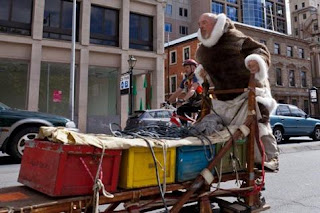So
where do I read the current situation sits? Somewhere along the following
lines:
-
existing environmental
parameters for collections are based on a blanket approach, and are
unnecessarily tight for all but the most vulnerable of artworks, e.g. panel
paintings, and ignore the issue of 'proofed' RH, that is the extremes to which
the artwork has already been exposed in its lifetime
-
major
museums and galleries worldwide are recognising this and implementing relaxed
parameters, e.g. The Tate, the Smithsonian and the V&A.
-
however
a significant proportion of the conservation profession are not convinced that
the risks in relaxing these parameters can be safely managed, a position best
articulated by the National Gallery
-
we are not going to achieve consensus amongst conservators internationally on
this and therefore there will be no new blanket environmental standards (
coming to this realisation was my big take away from Munich)
But
what we cannot do is to throw up our hands and say this is all too hard, not
least because, in my view, folks, this is about the planet ( witness the news from the Climate Conference in Doha this week). There are a
number of ways forward:
Firstly, in my
experience air conditioning engineers and building managers are often not
achieving the maximum efficiencies from HVAC systems, that is they know how
they are built and operated, but are not focused on achieving optimum
efficiency . To do so requires dialogue with the museum' s conservators, which
is invariably not taking place.
Secondly,
this dialogue can effectively achieve substantial energy savings without major
capital investment and
without sacrificing preservation quality, whilst safely managing any associated
risks to collections. I have seen it in action.
Thirdly, this requires a holistic understanding of the collections, HVAC systems and capabilities, buildings, outdoor climate and infrastructure/capabilities of the staff . What is clear is that every situation is unique.
This is way too important an issue to pull up the 'too hard' white flag on. You will hear more from me on this shortly.
















